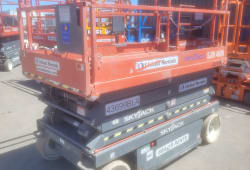Changing the Tracks On an Excavator: Quick Guide
5 Min read
)
April 29, 2023
Excavators are powerful machines used for a variety of tasks, from digging trenches to demolition. But all that power comes with a cost: eventually, the excavator tracks on an excavator will wear out and need to be replaced. Replacing the excavator tracks on an excavator can be a daunting task, but with the right tools and knowledge, it can be done safely and quickly.
As a professional working with heavy equipment and construction, changing the tracks on an excavator is an essential part of the job. In this guide, we will walk you through the step-by-step process of changing the steel tracks used on an excavator, from start to finish.
Understanding the Importance of Changing Tracks
Before we dive into the details of changing the tracks on an excavator, let's first discuss why it's important. Over time, tracks on an excavator can wear down, become ill-fitting, and lose traction. This can lead to reduced productivity and even dangerous situations. Changing the tracks on the front blade of your excavator can ensure that your machine operates at its best, and keeps your crew safe.
Preparing for the Job
Before changing the tracks, it's important to prepare the machine and the workspace. First, park the excavator on a level surface. Then, secure rubber tracks to the machine by engaging the safety lever and lifting the blade. Finally, put on your safety glasses and gloves, and gather your tools. You'll need a grease gun, a pry bar, a heavy-duty jack, and paper towels.
Tools and Materials Needed
Before beginning the track replacement process, it is important to have the right tools and materials on hand. The most important tools you will need are a track press and a track pin press. You will also need wrenches, a hammer, a chisel, and a grease gun. In addition, you will need a new track, track pins, and track bolts.
:format(webp))
Step 1: Preparing the Excavator
The first step in replacing the tracks on an excavator is to prepare the machine. This includes draining the oil, disconnecting the hydraulic hoses, and disconnecting the electrical connectors. Once these steps are complete, you can begin the process of either changing tracks on the excavator by removing the old track.
:format(webp))
Step 2: Removing the Old Track
Once the excavator is prepared, you can begin to remove the old track. Start by removing the track pins and bolts from the sprocket and idler. This can be done with a hammer and chisel. Once the pins and bolts and front idler are removed, the old track can be lifted off of the machine.
The first step in changing the tracks on your excavator is to remove the old track. First, locate the access hole on the track, and remove the grease valve with a grease fitting. Then, use a pry bar or a long pry bar to lift the track off of the sprocket teeth. It's important to be careful during this process, as tracks can be heavy and cumbersome. If necessary, use a heavy-duty jack to lift the track forward on the excavator and manually remove the track.
:format(webp))
Step 3: Installing the New Track
Once the old track has been removed, it's time to install the new track. Start by lining up the track pins with the sprocket and the idler wheel, and then inserting the track pins with a track pin press. Once the pins are in place, the track can be tightened with the track press. Once the track is tight, the track bolts can be inserted and tightened with a wrench.
Step 4: Adjusting Track Tension
After installing the new track, it's important to adjust the track tension. This can be done by using the grease gun to add grease to the track tensioner until it's in the proper position. . Once the lubricant and track tension use is applied, the tracks should move freely and the job is complete. It's important not to over-grease the tensioner, as this can cause the track to become too loose.
Finishing the Job
Once the new track is installed and properly tensioned, it's time to finish the job. Remove any excess dirt from the undercarriage and ensure that the sprocket teeth are aligned properly. You can do this by pushing the track in a few revolutions and observing its movement. Finally, test the machine by lifting and lowering the boom and bucket every few hours.
Safety Considerations
Safety is always a top priority when working with heavy equipment. When changing the tracks on your excavator, be sure to wear the proper protective gear, and use caution when lifting heavy components. Always double-check that rubber track on the machine is secure and that the track tension is properly adjusted before operating the excavator.
:format(webp))
Wrapping It All Up
Replacing the tracks on an excavator can be a daunting task, but with the right tools and knowledge, it is a job that can be done quickly and safely. By following the steps outlined above, you can ensure that your excavator's tracks are replaced correctly and that the job is done right the first time.

Caleb Woods is an experienced content specialist and an editor at Boom & Bucket, blending his journalism background with expertise in the heavy equipment industry. He delivers engaging, informative content to help professionals stay informed and make smarter decisions in the machinery market.
:format(webp))











